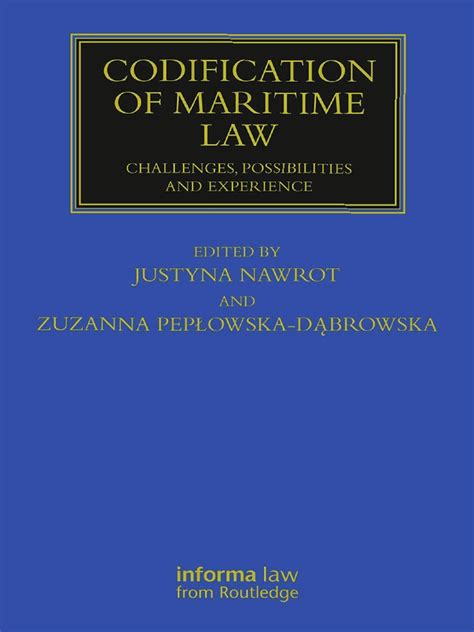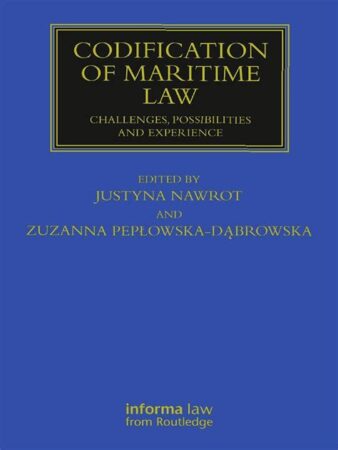
- Codification of Maritime Law: A Comprehensive Overview
-
FAQ about Codification of Maritime Law
- 1. What is codification of maritime law?
- 2. Why is codification of maritime law important?
- 3. What are the main sources of maritime law before codification?
- 4. What are the key principles underlying codification of maritime law?
- 5. How is maritime law codified?
- 6. What are some examples of codified maritime laws?
- 7. What are the benefits of using codified maritime laws?
- 8. What are the challenges in codifying maritime law?
- 9. Is codification of maritime law an ongoing process?
- 10. How can I access codified maritime laws?
Codification of Maritime Law: A Comprehensive Overview

Introduction
Greetings, readers! Welcome to this in-depth exploration of the codification of maritime law. As you delve into this comprehensive guide, we’ll journey through the complexities of this fascinating legal framework that governs the vast expanse of the world’s oceans and waterways.
The codification of maritime law is a vital endeavor that ensures the smooth functioning of international trade, protects the rights of seafarers, and safeguards our marine environment. By codifying these laws into a coherent system, we create a foundation for resolving disputes, fostering cooperation, and promoting sustainable practices at sea.
Historical Evolution of Maritime Law
a. Ancient Origins
The roots of maritime law can be traced back to ancient civilizations, such as the Phoenicians, Greeks, and Romans. These early maritime societies developed customs and practices to regulate trade, shipping, and navigation.
b. Medieval and Renaissance Period
During the Middle Ages and Renaissance, maritime law evolved through the influence of the Hanseatic League and the Italian city-states. The Amalfi Table (1075) and the Laws of Oléron (1160) were notable examples of early maritime codes that codified existing customs.
The Genesis of Modern Maritime Codification
a. The 19th Century: A Surge in International Trade
The 19th century witnessed a surge in international trade, leading to a need for a more comprehensive and uniform system of maritime law. In response, various maritime conventions were adopted, including the York-Antwerp Rules (1890) and the International Convention for the Unification of Certain Rules of Law Relating to Bills of Lading (1924).
b. The 20th Century: The United Nations and the International Maritime Organization (IMO)
The 20th century saw the establishment of the United Nations and the IMO. These organizations played a pivotal role in promoting the codification and harmonization of maritime law. The IMO, in particular, has been responsible for drafting and adopting numerous conventions that set international standards for maritime safety, environmental protection, and liability.
Aspects of Codified Maritime Law
a. Law of the Sea
The Law of the Sea establishes the legal framework for the use and exploration of the oceans. It defines territorial waters, exclusive economic zones, and the continental shelf.
b. Maritime Safety and Navigation
Maritime safety laws aim to prevent accidents at sea, protect seafarers, and safeguard marine life. They address issues such as ship safety standards, crew training, and the prevention of pollution.
c. Carriage of Goods by Sea
This area of maritime law governs the rights and responsibilities of shippers, carriers, and consignees involved in the transportation of goods by sea. It includes conventions such as the Hague and Hague-Visby Rules.
d. Marine Environmental Protection
Marine environmental protection laws regulate activities that have the potential to harm the marine environment. They aim to prevent pollution, conserve marine biodiversity, and protect sensitive marine habitats.
e. Maritime Labor
Maritime labor laws protect the rights and welfare of seafarers. They address issues such as working hours, safety standards, and social security.
Table of Key Maritime Conventions
| Convention | Year | Purpose |
|---|---|---|
| United Nations Convention on the Law of the Sea (UNCLOS) | 1982 | Codifies the law applicable to all uses of the sea |
| International Convention for the Safety of Life at Sea (SOLAS) | 1974 | Establishes safety standards for passenger ships |
| International Maritime Dangerous Goods Code (IMDG Code) | 1965 | Regulates the transport of dangerous goods by sea |
| MARPOL Convention | 1973 | Prevents pollution of the marine environment |
| Convention on the International Regulations for Preventing Collisions at Sea (COLREGS) | 1972 | Establishes rules for navigation to prevent collisions at sea |
Conclusion
The codification of maritime law is an ongoing process that reflects the ever-changing nature of the maritime industry. As technology advances and globalization continues, it is essential to ensure that the legal framework governing our oceans remains relevant, effective, and equitable. By exploring the various aspects of codified maritime law, we gain a deeper appreciation of its importance in fostering a safe, sustainable, and prosperous maritime environment.
Readers are encouraged to continue their exploration of maritime law through the following informative articles:
- The Role of Custom in Maritime Law
- Emerging Trends in International Shipping Law
- Dispute Resolution in Maritime Law
FAQ about Codification of Maritime Law
1. What is codification of maritime law?
Codification refers to the process of organizing and unifying laws, rules, and regulations relating to a specific subject matter into a single, comprehensive document or code. In the context of maritime law, codification involves the compilation and systematization of various maritime laws and principles into a cohesive and coherent body of law.
2. Why is codification of maritime law important?
Codification of maritime law brings several benefits, including:
- Enhancing clarity and certainty in the law
- Facilitating accessibility and ease of reference
- Promoting harmonization and uniformity in maritime regulations
- Reducing legal uncertainty and disputes
3. What are the main sources of maritime law before codification?
Prior to codification, maritime law was primarily derived from:
- Customary international law and practices
- National legislation and regulations
- Court decisions and precedents
- Treaties and conventions
4. What are the key principles underlying codification of maritime law?
Codification typically involves adhering to certain principles, such as:
- Clarity: Laws should be expressed in clear and unambiguous language.
- Comprehensiveness: The code should cover all relevant aspects of the subject matter.
- Accessibility: The code should be easily accessible and understandable to users.
- Coherence: The code should be internally consistent and avoid contradictions.
5. How is maritime law codified?
Codification of maritime law is usually undertaken by international organizations or national governments. It involves the following steps:
- Gathering and reviewing existing laws and practices
- Identifying key principles and concepts
- Drafting a comprehensive code
- Obtaining consensus and ratification
- Enacting the code into law
6. What are some examples of codified maritime laws?
Examples of codified maritime laws include:
- The United Nations Convention on the Law of the Sea (UNCLOS)
- The Collision Regulations (COLREGS)
- The International Convention for the Prevention of Pollution from Ships (MARPOL)
7. What are the benefits of using codified maritime laws?
Codified maritime laws provide numerous advantages, such as:
- Increased predictability and consistency in legal outcomes
- Reduced legal costs and delays
- Enhanced efficiency in maritime operations
- Improved safety and environmental protection
8. What are the challenges in codifying maritime law?
Codification can present certain challenges, including:
- Balancing diverse national interests
- Resolving conflicts between existing laws
- Keeping pace with technological advancements
- Ensuring enforcement and compliance
9. Is codification of maritime law an ongoing process?
Yes, codification of maritime law is an ongoing process. As maritime activities evolve, new laws and regulations are constantly being developed and incorporated into the existing code.
10. How can I access codified maritime laws?
Codified maritime laws are typically available through official government websites, legal databases, and international organizations.




